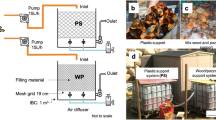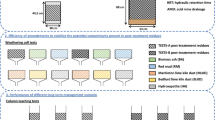Conclusions
The data obtained in these preliminary experiments clearly demonstrate that a bacteria and nutrient top-dressing is capable of generating anaerobiosis and of increasing pH. These changes appear to correspond to the depths at which increases in the bacterial population are noted. This suggests that the bacterial population had utilized the available oxygen, and had promoted anaerobic conditions and reduced acid production by plugging the available pore spaces through cell growth and exopolymer production. This interpretation is strongly supported by the reduction in permeability noted after top-dressing with bacteria and nutrient.
As indicated by the cell counts and pH data, the bacteria and nutrient top-dressing prevented the development of acidogenic conditions throughout the 30-cm unoxidized Denison tailings column. This strategy was less successful in the oxidized Denison tailings, although an abundant bacterial population and large increases in pH were generated in the upper 6 cm in two experiments.
It is of interest that the pH and bacterial population increase noted in oxidized tailings top-dressed with nutrient only was very similar to tailings top-dressed with both bacteria and nutrient. It may therefore be possible, in a field situation, to treat tailings with nutrient alone to enhance the indigenous population. However, before this strategy can be entertained, further testing is obviously required to determine if the rate of permeability reduction is equivalent for both treatments. A bacteria and nutrient top-dressing may possibly provide a greater initial rate of permeability reduction than a nutrient top-dressing alone, which must first stimulate the indigenous population.
Our data suggest that it may be expedient to top-dress unoxidized tailings before oxidation can occur.
Similar content being viewed by others
References
Dubrovsky, N. M., Morin, K. A., Cherry, J. A., and Smyth, D. J. A. (1985),Water Poll. Res. J. Canada 19, 55–89.
Morin, K. A., Cherry, J. A., Lim, T. P., and Vivyurkan, A. J. (1982),Can. Geotech. J. 19, 49–62.
Blair, R. D., Cherry, J. A., Lim, T. P., and Vivyurka, J. J. (1980),Proceedings, 1st International Conference on Uranium Mine Waste Disposal. Society of Mining Engineers of AIME, NY, pp. 411–444.
Boorman, R. S. and Watson, D. M. (1976),CM Bull. 69, 86–96.
Herlihy, A. T., Kaufmann, P. R., Mitch, M. E., and Brown, D. D. (1990),Water Air Soil Poll. 50, 91–107.
Stumm, W. and Morgan, J. J. (1981),Aquatic Chemistry: An Introduction Emphasizing Chemical Equilibria in Natural Waters, 2d ed., Wiley & Sons, Toronto, 780 pp.
Nicholson, R. V., Gillham, R. W., Cherry, J. A., and Reardon, E. J. (1989),Can. Geotech. J. 26, 1–8.
Kelly, M. (1988),Mining and the Freshwater Environment. Elsevier Applied Science, NY, 231 pp.
Shaw, J. C., Bramhill, B., Wardlaw, W. C, and Costerton, J. W. (1985),Appl. Environ. Microbiol. 49, 693–701.
MacLeod, F. A., Lappin-Scott, H. M., and Costerton, J. W. (1988),Appl. Environ. Microbiol. 54, 1365–1372.
Lappin-Scott, H. M., Cusack, F., and Costerton, J. W. (1988),Appl. Environ. Microbiol. 54, 1373–1382.
Author information
Authors and Affiliations
Rights and permissions
About this article
Cite this article
Blenkinsopp, S.A., Herman, D.C., Mccready, R.G.L. et al. Acidogenic mine tailings the use of biofilm bacteria to exclude oxygen. Appl Biochem Biotechnol 34, 801–809 (1992). https://doi.org/10.1007/BF02920598
Issue Date:
DOI: https://doi.org/10.1007/BF02920598




